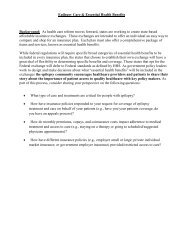Legal Rights of Children with Epilepsy in School & Child Care
Legal Rights of Children with Epilepsy in School & Child Care
Legal Rights of Children with Epilepsy in School & Child Care
You also want an ePaper? Increase the reach of your titles
YUMPU automatically turns print PDFs into web optimized ePapers that Google loves.
Myoclonic seizures: Seizures <strong>in</strong> which the person experiences quick muscle contractions<br />
that usually occur on both sides <strong>of</strong> the body at the same time. They look like quick<br />
muscle jerks. Generalized seizure.<br />
Partial seizures: Seizures <strong>in</strong> which the electrical fir<strong>in</strong>gs <strong>of</strong> the neurons are limited to a<br />
specific area <strong>of</strong> one side <strong>of</strong> the bra<strong>in</strong>.<br />
Simple partial seizures: Dur<strong>in</strong>g these seizures a person rema<strong>in</strong>s aware <strong>of</strong> what is go<strong>in</strong>g<br />
on but may be limited <strong>in</strong> how he or she can react. The person may not be able to speak,<br />
or may experience t<strong>in</strong>gl<strong>in</strong>g or pa<strong>in</strong>, visual distortions, or other symptoms that may warn <strong>of</strong><br />
more severe seizures to come.<br />
Seizure action plan: A plan that is designed to provide basic <strong>in</strong>formation about the<br />
student’s seizures and treatments. A completed plan should be provided to all relevant<br />
school personnel at the beg<strong>in</strong>n<strong>in</strong>g <strong>of</strong> the school year, when a diagnosis <strong>of</strong> epilepsy is<br />
made or when a change <strong>in</strong> health status occurs. The plan should be signed and<br />
approved by the student’s treat<strong>in</strong>g physician.<br />
Status epilepticus: A period <strong>of</strong> prolonged seizure activity either because <strong>of</strong> one prolonged<br />
seizure or because <strong>of</strong> a series <strong>of</strong> seizures <strong>with</strong>out the person return<strong>in</strong>g to basel<strong>in</strong>e.<br />
Current medical def<strong>in</strong>itions consider 10 m<strong>in</strong>utes as the amount <strong>of</strong> time after which<br />
un<strong>in</strong>terrupted seizure activity would be considered status epilepticus. It is possible that<br />
bra<strong>in</strong> damage or death can result from status seizures. Dur<strong>in</strong>g status seizures, problems<br />
can arise if there is pulmonary or cardiac arrest that is not promptly treated. More <strong>of</strong>ten,<br />
however, serious negative consequences occur hours or days after the onset <strong>of</strong> status as<br />
a result <strong>of</strong> prolonged stress, oxygen deprivation and systemic complications such as<br />
organ failure.<br />
Tonic-clonic seizures: The most common type <strong>of</strong> seizure (sometimes called “grand mal”<br />
seizures). They beg<strong>in</strong> <strong>with</strong> a tonic phase, <strong>in</strong> which the arms and legs stiffen, and then<br />
cont<strong>in</strong>ue <strong>with</strong> a clonic phase, <strong>in</strong> which the limbs and face jerk. Dur<strong>in</strong>g the tonic portion <strong>of</strong><br />
a seizure, a person may have an <strong>in</strong>itial vocalization followed by their breath<strong>in</strong>g slow<strong>in</strong>g or<br />
stopp<strong>in</strong>g; dur<strong>in</strong>g the clonic portion, breath<strong>in</strong>g usually returns, but may be irregular, noisy<br />
or seem labored. The person may be <strong>in</strong>cont<strong>in</strong>ent and may bite his or her tongue or the<br />
<strong>in</strong>side <strong>of</strong> his or her mouth dur<strong>in</strong>g the seizure. Generalized seizure.<br />
Tonic seizures: Seizures <strong>in</strong> which the person’s leg, arm, or body muscles stiffen. The<br />
person’s legs may extend. The person usually rema<strong>in</strong>s conscious. Generalized seizure.<br />
Vagus nerve stimulator (VNS): The VNS is similar to a pacemaker, but it stimulates the<br />
vagus nerve <strong>in</strong> the neck, <strong>in</strong>stead <strong>of</strong> the heart. The VNS is usually implanted <strong>in</strong> the upper<br />
left chest or under the arm; it stimulates, on an ongo<strong>in</strong>g basis, the vagus nerve, which<br />
then sends electrical impulses to the parts <strong>of</strong> the bra<strong>in</strong> that affect seizures. If a person<br />
has a seizure aura or beg<strong>in</strong>s to have a seizure, the VNS can be swiped <strong>with</strong> a magnet to<br />
send additional electrical current to abort or m<strong>in</strong>imize the seizure.<br />
(301) 459-3700 • (888) 886-EPILEPSY • FAX: (301) 577-2684 • postmaster@efa.org •<br />
www.epilepsyfoundation.org<br />
3








